تتبع المساعدات النقدية والقسائم
لتزم الموقعون على الصفقة الكبرى بزيادة استخدام المساعدات النقدية والقسائم، واستخدام علامات مشتركة لقياس هذه الزيادات. على الرغم من بدء تتبع حجم المساعدات النقدية والقسائم بشكل أكثر فعالية، إلّا أنه ثمة تحديات تقنية وسياسية. وهذا يضم ما يلي:
- تحديد البيانات التي يجب جمعها وطريقة القيام بذلك
- ضمان الالتزام باستخدام فئات وأنظمة البيانات
- معالجة أوجه القصور في أنظمة إعداد التقارير الحالية التي لم يتم تصميمها في كثير من الأحيان لتضمين أو تفصيل النقد والقسائم والطرائق الأخرى
- التوصل إلى اتفاق مشترك حول الفئات المعيارية للإبلاغ لتجنب البيانات غير الكاملة وغير المتسقة.
الأولويات الحالية
شاركت شبكة CALP، من عام 2017 إلى عام 2019، في قيادة مسار العمل الفرعي للصفقة الكبرى بشأن تتبع المساعدات النقدية والقسائم مع المديرية العامة للحماية المدنية الأوروبية وعمليات المساعدة الإنسانية، بهدف رئيسي يتمثل في الاتفاق على الحد الأدنى من المتطلبات لتتبع المساعدات النقدية والقسائم. يتضمن ذلك دمج المساعدات النقدية والقسائم في أنظمة ومنصات إعداد التقارير الرئيسية المشتركة بين الوكالات، أي خدمة التتبع المالي التابعة لمكتب تنسيق الشؤون الإنسانية ووحدة مشروع دورة البرمجة الإنسانية، ومعيار بيانات مبادرة الشفافية الخاصة بالمعونة الدولية، وإعداد تقارير 3W (وهي تتمثل في من الذي سيفعل وماذا سيفعل وأين سيفعل). تم الآن دمج مسار العمل الفرعي الخاص بتتبع المساعدات النقدية والقسائم في مسار العمل الفرعي للكفاءة والفعالية والقيمة مقابل المال، والذي ستستمر شبكة CALP في قيادته.
Featured content

Tracking Cash & Voucher Assistance Workshop – Part 2: Report
Presentation
Do you want to read the latest on discussions on how to best track cash and voucher assistance in global interagency reporting systems? The CALP Network and ECHO have just released Tracking Cash & Voucher Assistance Workshop – Part 2: Report. Key recommendations emerging from the workshop are summarized below. These will be used in the coming months as a basis to develop guidance for...

Measuring Cash Transfer Programming – Scoping study
Report
This scoping study explores technical and policy issues that are constraining progress towards better measurement and reporting of Cash Transfer Programming (CTP) and addresses these to identify ways forward. The study was developed with the following objectives: • Map and document how different implementing agencies and donors are measuring cash and voucher programming data at the...

Tracking Cash and Voucher Assistance: Agreements, recommendations and minimum requirements from the Grand Bargain cash workstream
Guidelines and Tools
This document comprises the key outputs of the work undertaken through the Tracking Cash and Voucher Assistance (CVA) Working Group from 2017 to 2019. The Tracking CVA Working Group was established as the
platform for engagement and decision-making for the sub-workstream on Tracking CVA, which is part of the Grand Bargain Cash Workstream. The Tracking CVA sub-workstream was co-led by the the...
Thematic lead
Latest
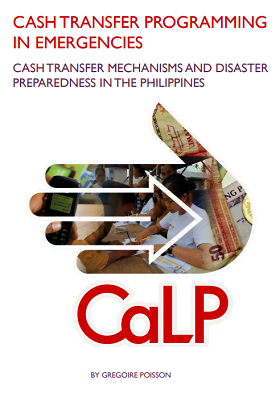
Cash transfer mechanisms and disaster preparedness in the Philippines
Report
The use of cash to deliver assistance in case of humanitarian emergency remains a relatively new approach in the Philippines, and aid agencies are at the early stages of developing guidelines, policies and organizational capacity to implement cash projects. Project managers lack support and guidance with...
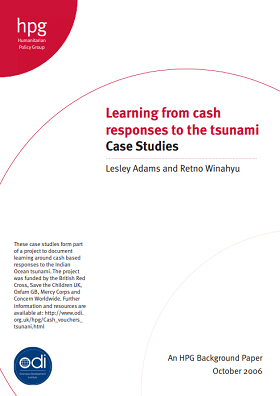
Learning from Cash Responses to the Tsunami: Case Studies
Case Study
These case studies form part of a project to document learning around cash based responses to the Indian Ocean tsunami. The project was funded by the British Red Cross, Save the Children UK, Oxfam GB, Mercy Corps and Concern Worldwide.

Results of the Market Information and Food Insecurity Response Analysis (MIFIRA) framework conducted in two locations in Kenya
Case Study
This research paper shows the results of the MIFIRA framework which was applied through a Catholic Relief Services programme in one urban and one rural location in Kenya. The difference between urban and rural food security is explained and then the findings of the two case studies are described in...
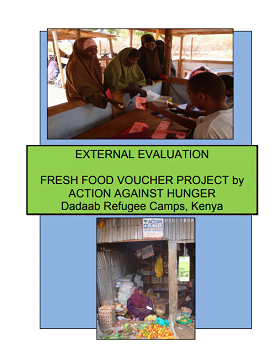
External Evaluation: Fresh Food Voucher Project by Action Against Hunger in Dadaab Refugee Camps, Kenya
Report
The town of Dadaab in North Eastern Kenya is home to three refugee camps: Hagadera, Dagahaley and Ifo hosting over 240,000 people. The camps were established in mid-1992 after the closure of the Liboi camp, which was too close to the Kenya/Somali border to ensure adequate security. Continued insecurity in...
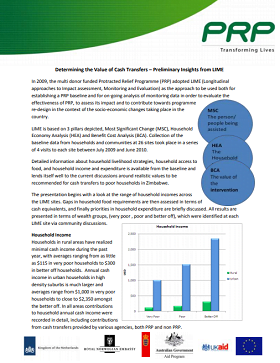
Determining the Value of Cash Transfers – Preliminary Insights from LIME
Report
In 2009, the multi donor funded Protracted Relief Programme (PRP) adopted LIME (Longitudinal approaches to Impact assessment, Monitoring and Evaluation) as the approach to be used both for establishing a PRP baseline and for on-going analysis of monitoring data in order to evaluate the effectiveness of...

Voucher Fairs: A Quick Delivery Guide (screen version)
Guidelines and Tools
A Quick Delivery Guide to using voucher fairs to implement a market-based emergency response. Prepared as a practical tool, this guide provides a brief synthesis of the necessary preconditions and advantages and disadvantages of using voucher fairs. It also provides practical implementation tips.

Support to Economic Recovery of Urban Households in Karoi town, Zimbabwe (the CALP Network Case Study)
Report
In the urban area of Karoi, Zimbabwe, Save the Children combined cash for work with livelihoods support to meet the immediate food needs and support the economic recovery of poor families. The project used smart cards to transfer cash to beneficiaries, which proved to be an appropriate payment...
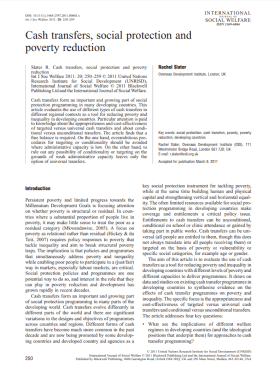
Cash Transfers, Social Protection and Poverty Reduction
Policy paper
Cash transfers form an important and growing part of social protection programming in many developing countries. This article evaluates the use of different types of cash transfers in different regional contexts as a tool for reducing poverty and inequality in developing countries. Particular attention is...

Evaluation of Livelihoods Projects Sri Lanka Tsunami Specific Plan
Report
Spanish Red Cross has wide experience in livelihoods programming mainly in South America and South Africa over the last twenty years. However the projects that were developed in response to the impact of the Indian Ocean tsunami were the first time that the SRC used cash grants as a modality for its...
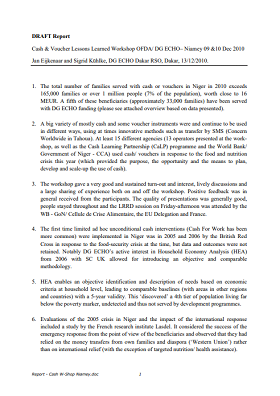
Cash & voucher lessons learned workshop OFDA/ DG ECHO
Report
An overview of discussions of the Cash & voucher lessons learned workshop OFDA/ DG ECHO – Niamey 09 &10 Dec 2010.
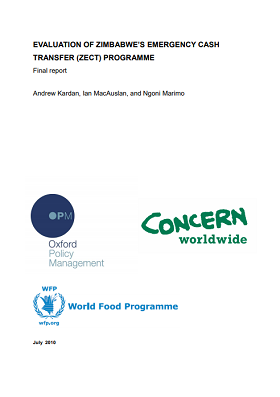
Evaluation of Zimbabwe’s Emergency Cash Transfer (ZECT) Programme
Case Study
Concern Worldwide have been delivering food aid in three rural districts of Zimbabwe (Gokwe North, Gokwe South and Nyanga) since 2002 as part of the World Food Programme’s (WFP) Vulnerable Group Feeding (VGF) programme. The VGF provided a monthly food bundle of 10kg staple, 1kg beans and 600ml oil per...
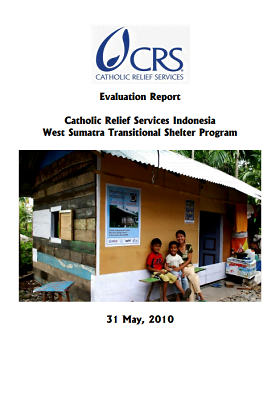
Catholic Relief Services Indonesia West Sumatra Transitional Shelter Program
Report
This evaluation report looks at CRS’ shelter programme in West Sumatra following an earthquake, which used cash grants to assist households to build safe, adequate, comfortable and durable transitional shelters. The report gives an overview of the programme and presents the findings from a comprehensive...
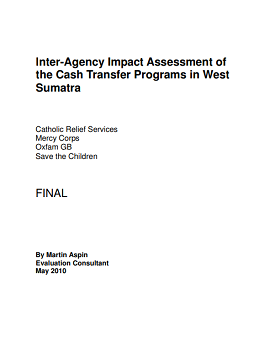
Inter-Agency Impact Assessment of the Cash Transfer Programs in West Sumatra
Case Study
Following the 2009 earthquake in West Sumatra, cash transfer programming (CTP) has proven successful in delivering a fast and effective recovery response—providing households the opportunity to recover shelter and basic needs for their livelihoods. Success of these CTPs has been supported well by the...
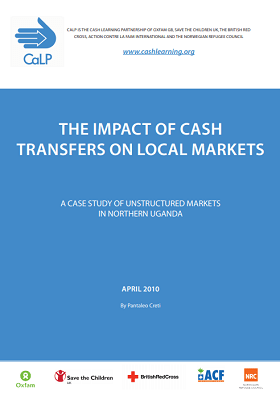
The Impact of Cash Transfers on Local Markets: A Case Study of Unstructured Markets in Northern Uganda
Case Study
This report explores the effects of cash transfers on local markets. It tests the hypothesis that ‘cash transfers to poor households lead to integration of markets in remote areas and strengthen existing well-integrated market systems’. To test the hypothesis, a case study was conducted in Northern...
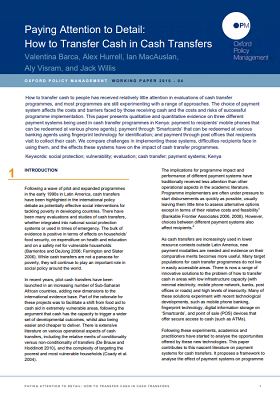
Paying attention to detail: How to transfer cash in cash transfers
Report
This policy working paper looks at various delivery mechanisms which can be used to transfer cash to people in cash interventions. It discusses how these affect the costs, and the barriers, faced by those receiving cash as well as the costs and risks to implementing agencies of successful programme...
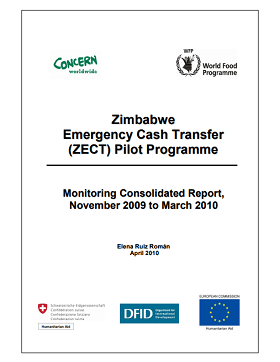
Zimbabwe Emergency Cash Transfer (ZECT) Pilot Programme: Monitoring Consolidated Report, November 2009 to March 2010
Case Study
Concern Worldwide Zimbabwe together with WFP implemented the Zimbabwe Emergency Cash Transfer (ZECT) Pilot Programme in three districts of Zimbabwe as part of the Vulnerable Feeding Group intervention for the food shortages of 2009/2010. In spite of its limited duration (5 months), the ZECT was highly...
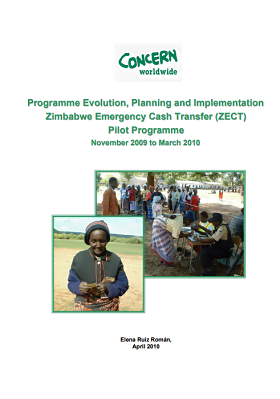
Programme Evolution, Planning and Implementation: Zimbabwe Emergency Cash Transfer (ZECT) Pilot Programme
Case Study
The aim of this document is to draw lessons from the Zimbabwe Emergency Cash Transfer (ZECT) Pilot Programme evolution, planning and implementation. Since this was a pilot programme, documentation of the process of its development was viewed as a crucial programme output. The target audience for this...

Banking on Solutions: A Real-time Evaluation of UNHCR’s Shelter Grant Programme for Returning Displaced People in Northern Sri Lanka
Case Study
Approximately 300,000 people were displaced in the final phase of fighting between the army and the LTTE, a 26-year conflict that came to a definitive end on 20 May 2009, with victory for the SLA. Initially transferred to the area of Menik Farm and other closed camps in northern Sri Lanka, where they were...
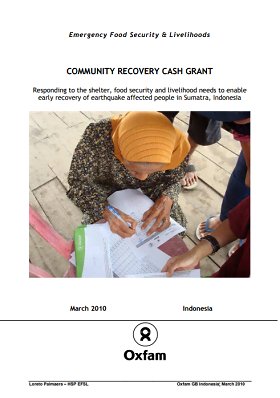
Community Recovery Cash Grant: Responding to the shelter, food security and livelihood needs to enable early recovery of earthquake affected people in Sumatra, Indonesia
Case Study
This document gives a technical review of the activities and outstanding issues pertaining to the implementation of Oxfam’s recovery cash grant distribution in response to the 2009 earthquake in West Sumatra, Indonesia. Following the rapid assessment conducted a week after the earthquake, Oxfam has...
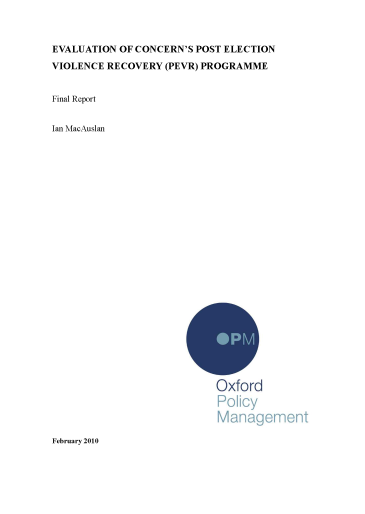
Evaluation of Concern’s Post Election Violence Recovery (PEVR) programme
Case Study
Concern’s Post Election Violence Recovery (PEVR) Programme was a cash transfer programme operating in areas of Kenya (Nairobi, Nyanza, and the Rift Valley) affected particularly badly by the violence that followed the announcement of the national election results in late 2007. Building on several other...



